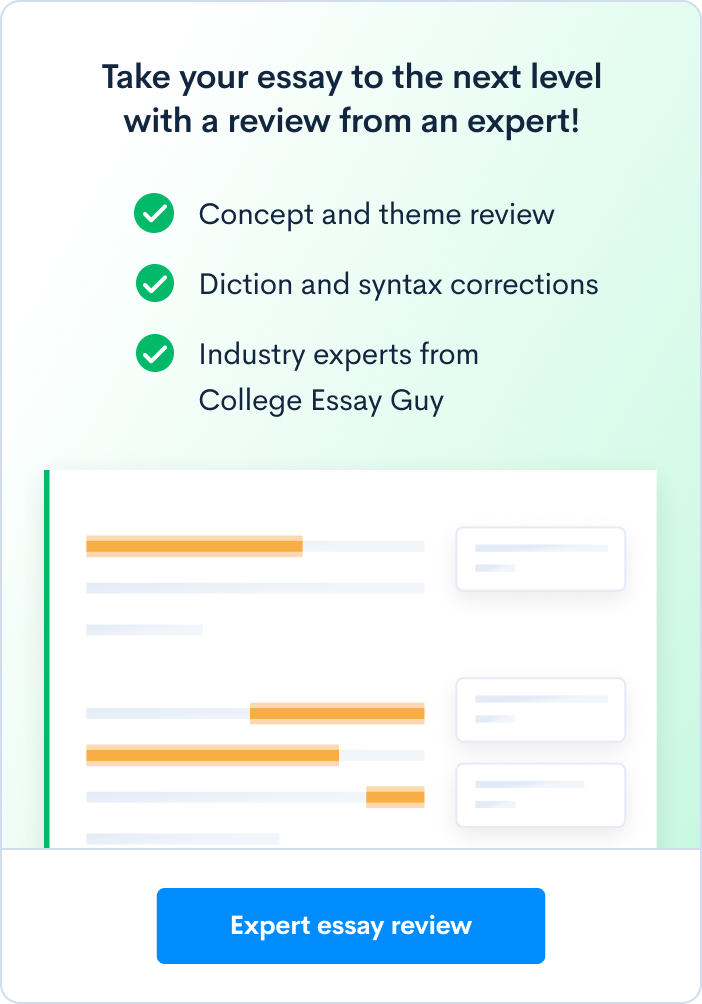Ultimate Guide to the AP U.S. History Exam
The AP U.S. History exam is one of the most popular AP exams among self-studiers and enrolled students alike. In 2019, just under 500,000 students took the AP U.S. History exam, making it the second most popular AP exam, trailing only English Language. If you’re planning to take the AP U.S. History exam, whether you have taken the class or self-studied, read on for a breakdown of the test and CollegeVine’s advice for to best prepare for it. In 2020, the AP U.S. History exam will be administered on Friday, May 8 at 8:00 am. For a comprehensive list of all the AP exam dates and times, check out our blog 2020 AP Exam Schedule: Everything You Need to Know. The AP U.S. History exam measures your ability to analyze historical data, assess historical evidence, analyze significant issues in U.S. history, and understand historical sources, images, graphs, and maps. Throughout the AP U.S. History course, students explore eight themes, using them to make connections between historical occurrences in different times and places. Those themes are: In 2015, the AP U.S. History exam was redesigned to reflect a less partisan account of history and to present information in a more factual manner, with less interpretation offered to students. Students are now expected to understand the sequence of major historical events as presented, and interpret the significance of these events themselves. The new exam is also now more focused on analytical and reading comprehension skills, rather than purely fact-based knowledge. It’s important to remember when preparing for the exam to use material produced in 2015 and after, as older material will be outdated and no longer helpful in preparing for the exam. The AP U.S. History course consists of nine units, covering U.S. history from 1491 through the present. Below is a look at how the units break down and what percentage of the exam they represent. The AP U.S. History exam is one of the longer AP exams, clocking in at three hours and 15 minutes. It is comprised of these sections: Section 1(a): Section 1(a) takes 55 minutes, contains 55 multiple-choice questions, and accounts for 40% of your total score. Source: The College Board Section 1(b): Section 1(b) contains three short-answer questions, takes 40 minutes, and accounts for 20% of your total score. Source: The College Board Section 2: The last section contains two free-response questions and takes one hour and 40 minutes. The final section comprises one document-based question (DBQ), which you have an hour to answer, and one long essay that you are given 40 minutes to write. This section makes up 40% of your score, with 25% coming from the document-based question and 15% from the long essay. In 2019, 53.6% of students who took the AP U.S. History received a score of 3 or higher. Only 11.8% of students received the top score of 5, while 24.3% scored a 1 on the exam. For more score distributions, see the 2019 AP Student Score Report. Keep in mind that credit and advanced standing based on AP scores varies widely from college to college. Be sure to check whether the schools on your list accept AP exam credit, and if so, what scores they require. A full course description that can help guide your studying and understanding of test can be found in the College Board’s AP U.S. History course description. It’s important to start your studying off with a good understanding of your existing knowledge. Although the College Board AP U.S. History website provides a number of sample test questions, it does not provide a complete sample test. Additional sample questions are found in the College Board’s AP U.S. History Course and Exam Description. You can also find a practice test in many of the official study guides, and some even include a diagnostic test to act as your initial assessment. The AP U.S. History course covers an enormous amount of material, so you should allow plenty of time to prepare. Because you’re asked to frame historical developments in different times and places, you’ll need to learn significant events, people, developments, and processes from U.S. history and employ the thinking skills and methods historians use to study the past. These include analyzing primary and secondary sources, making historical comparisons, chronological reasoning, and argumentation. Go to the Source: The College Board provides a number of resources for planning your studies. These include a series of videos summarizing the course, a list of example textbooks, and an endorsed study guide. The official course description is also an invaluable tool to shape your understanding of the course content. Ask the Experts: For a more specific idea of where to focus your studying, consider using a formal study guide. The Princeton Review’s Cracking the AP U.S. History Exam, 2020 Edition: Proven Techniques to Help You Score a 5 is a comprehensive guide that includes summaries of every major historical event you’ll need to know, along with scoring explanations. Another solid choice is Barron’s AP United States History, 3rd Edition which is written in much the same format as the AP exam and can be purchased with optional flashcards. Find Free Resources: There are also a number of free study resources available online. Khan Academy has a comprehensive APUSH study guide that includes videos and sample questions. Many AP teachers have also posted complete study guides, review sheets, and test questions. Be careful when accessing these though, as some will be from previous versions of the exam. Remember, anything published before 2015 is now obsolete for the AP U.S. History course and exam. Study on-the-go with an app: A convenient way to study is to use one of the recently developed apps for AP exams. These can be free or cost a small fee, and they provide an easy way to quiz yourself on-the-go. Make sure you read reviews before choosing one—their quality varies widely. Here’s an example of a free APUSH app created by a high school teacher. Once you have your theory down, test it out by practicing multiple-choice questions. You can find these in most study guides or through online searches. You could also try taking the multiple-choice section of another practice exam. Keep in mind that many of the questions on this exam test your ability to comprehend and analyze a passage of text, a table of information, or a map, rather than recall any specific historical knowledge. As such, practicing multiple-choice questions is just as important as having a solid grasp on the content of the course. The College Board Course Description includes many practice multiple-choice questions along with explanations of their answers. As you go through these, try to keep track of which areas are still tripping you up, and go back over this theory again. Focus on understanding what each question is asking and keep a running list of any vocabulary that is still unfamiliar. The AP U.S. History exam is different from other AP exams in that it consists of five free-response questions of varying length and content. To be successful in these sections, you should know what to expect from each question. Short Answer: The first three free-response questions are considered “short answer” and you will be allowed 40 minutes to complete them all. These questions tend to have multiple parts, with each requiring a very specific and limited response. You will probably be asked to interpret a graph or figure, compare and contrast the effects of different cultural approaches from specific time periods, or list distinct precipitating factors of significant historical events. You should be able to answer each part of these questions in a short, succinct paragraph. Khan Academy has great videos on sample APUSH short answers. Document-Based Question: The second free-response section is a document-based question, and you will have one hour to complete it. This one question alone is worth 25% of your total exam score. To master it, you will need to carefully read the question, practice active reading skills while reviewing the documents, and make a strong outline before you begin to write. The exam will provide you with a rough outline of key considerations in the scoring of your work. This includes the definition of a strong thesis and specific elements to include in your essay, such as six of the seven sources, context for at least four of them, and one piece of outside evidence. Be sure to completely review these requirements and check them off as you are outlining and writing your response. Many points are lost by students who simply forget to include one of the scoring criteria. The YouTube channel Heimler’s History has an awesome video on how to write the APUSH DQB. Long Essay: The last free-response section is a long-essay response, and you will have 40 minutes to complete it. It is worth 15% of your total exam score. This section gives you the choice of three separate prompts—remember that you only need to answer one of them. As in the document-based question above, you will be provided with a rough outline of key considerations for the scoring of your work. These include a strong thesis, application of your historical thinking skills, ability to support your argument with specific examples, and the synthesis of your response into a greater historical context. For more details about how the document-based section and long-essay section are scored, review the College Board’s scoring rubric. To see authentic examples of past student responses and scoring explanations for each, visit the College Board’s Student Samples, Scoring Guidelines, and Commentary. Khan Academic has videos with APUSH long essay examples. As you did at the very beginning of your studying, take a practice test to evaluate your progress. You should see a steady progression of knowledge, and it’s likely that you will see patterns identifying which areas have improved the most and which areas still need improvement. If you have time, repeat each of the steps above to incrementally increase your score. If you’re taking the AP course associated with this exam, your teacher will walk you through how to register. If you’re self-studying, check out our blog post How to Self-Register for AP Exams. For information about what to bring to the exam, see our post What Should I Bring to My AP Exam (And What Should I Definitely Leave at Home)? CollegeVine can’t predict how well you’ll perform on the AP U.S. History exam, but we can help you assess your odds of getting accepted into your dream school. Our free, data-driven chancing engine takes into account numerous factors such as GPA, standardized test scores, and extracurricular activities to show you how you stack up against other applicants and how to improve your chances. Sign up for your free CollegeVine account to start using our chancing engine today! For more information about AP exams, be sure to check out these other CollegeVine posts: When is the AP U.S. History Exam?
What Does the AP U.S. History Exam Cover?
AP U.S. History Exam Course Content
AP U.S. History Unit
Topics You May Cover
Percentage of Exam Score
Period One: 1491-1607
Native American societies; how and why Europeans first explored and then began to colonize the Americas.
4%-6%
Period 2: 1607–1754
The colonies established in the New World by the Spanish, French, Dutch, and British.
6%-8%
Period 3: 1754–1800
The events that led to the American Revolution and the formation of the United States, examining the early years of the republic.
10%-17%
Period 4: 1800–1848
How the U.S. developed politically, culturally, and economically in this period.
10%-17%
Period 5: 1844–1877
How the U.S. expanded and the events that led to the secession of Southern states and the Civil War.
10%-17%
Period 6: 1865–1898
The U.S.’s economic and demographic shifts in this period and their links to cultural and political changes.
10%-17%
Period 7: 1890–1945
America’s changing society and culture and the causes and effects of the global wars and economic meltdown of this period.
10%-17%
Period 8: 1945–1980
The rivalry between the Soviet Union and the United States; the growth of various civil rights movements; and the economic, cultural, and political transformations of this period.
10%-17%
Period 9: 1980–Present
The advance of political conservatism, developments in science and technology, and demographic shifts that had major cultural and political consequences in this period.
4%-6%
How Long is the AP U.S. History Exam? What is the Format?
Section
Number of Questions
Time
Percentage of Score
Multiple Choice
55
55 minutes
40%
Short Answer
3
40 minutes
20%
DBQ
1
1 hour
25%
Long Essay
1 (choice between three questions)
40 minutes
15%
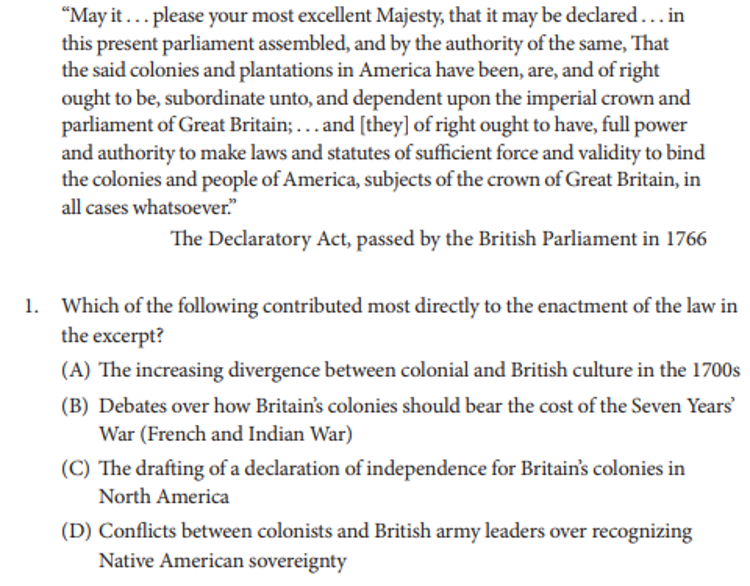
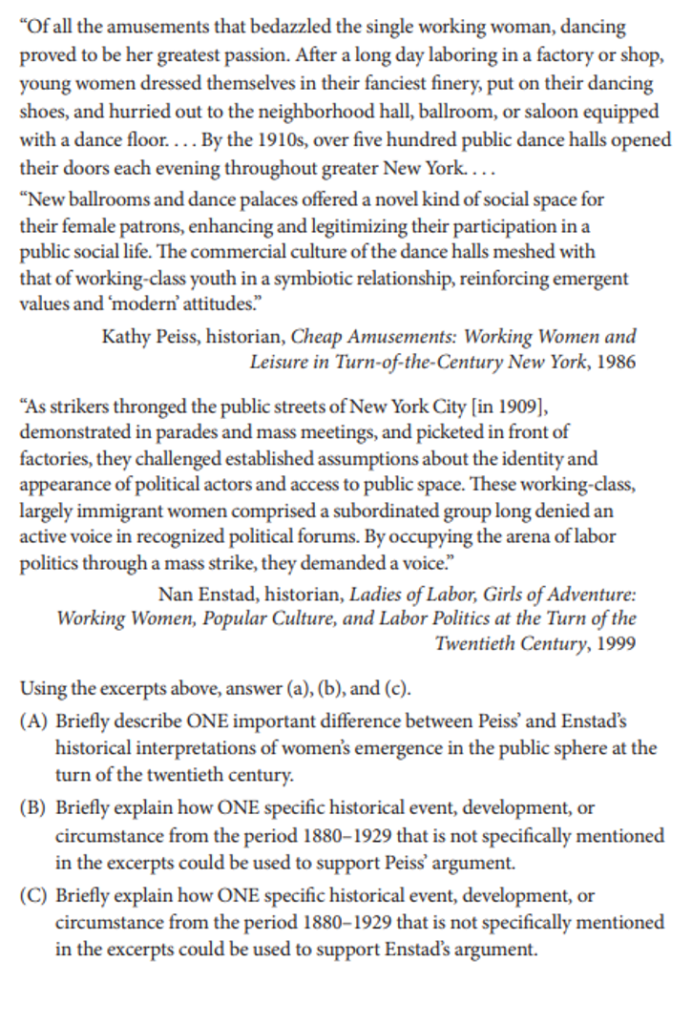
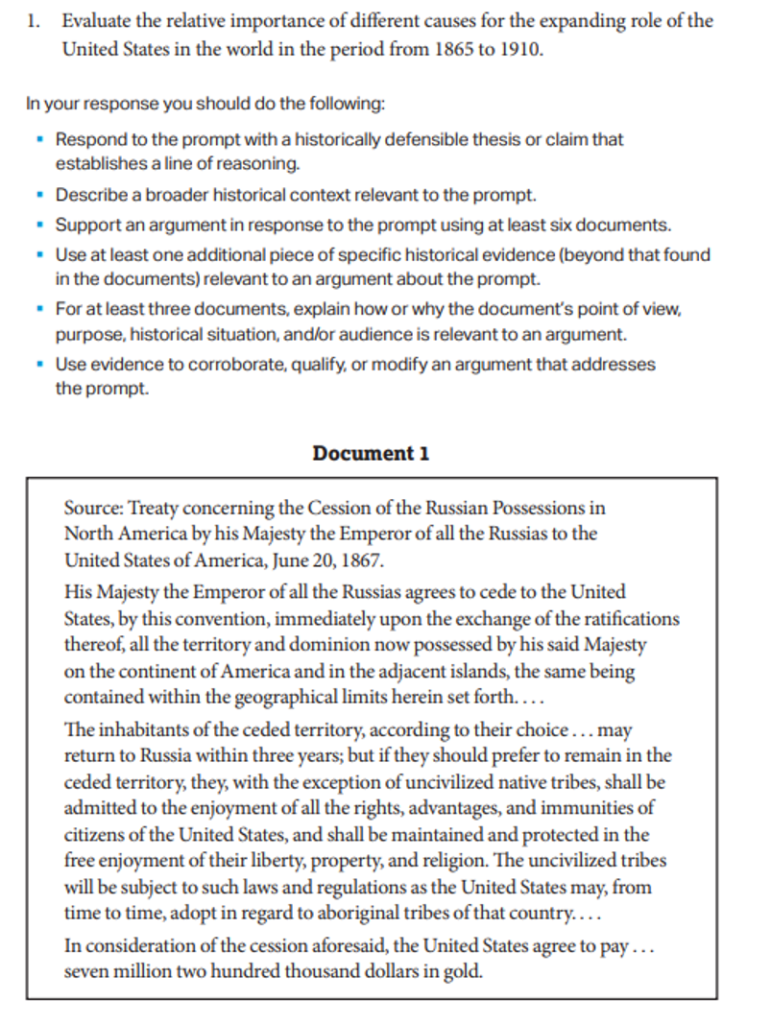
Source: The College Board
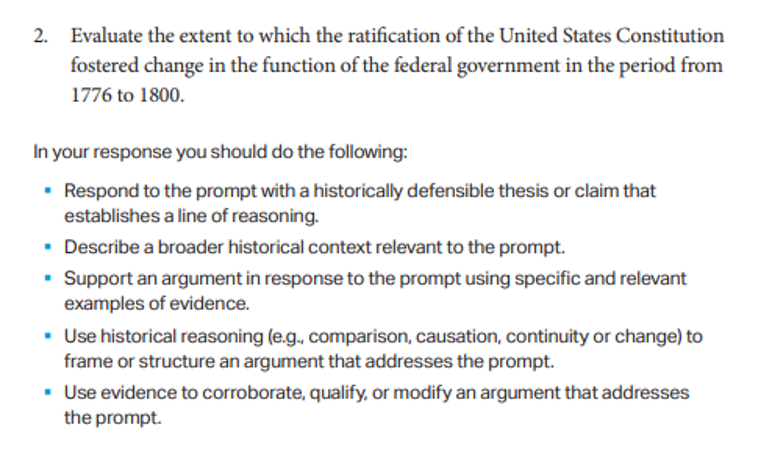
Source: The College BoardAP U.S. History Score Distribution, Average Score, and Passing Rate
Exam
5
4
3
2
1
AP U.S. History
11.8%
18.4%
23.4%
22%
24.3%
Best Ways to Study for the AP U.S. History Exam
Step 1: Assess Your Skills
Step 2: Study the Material
Step 3: Practice Multiple-Choice Questions
Step 4: Practice Free-Response Questions
Step 5: Take Another Practice Test
Step 6: Exam Day Specifics

